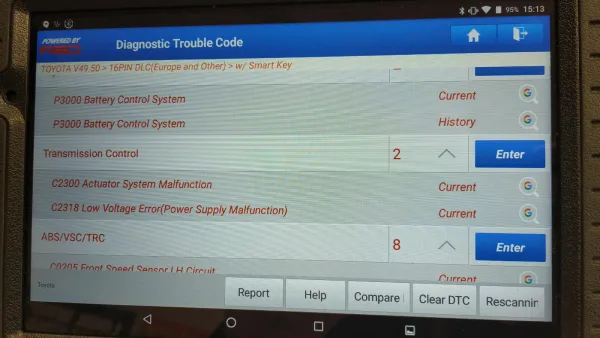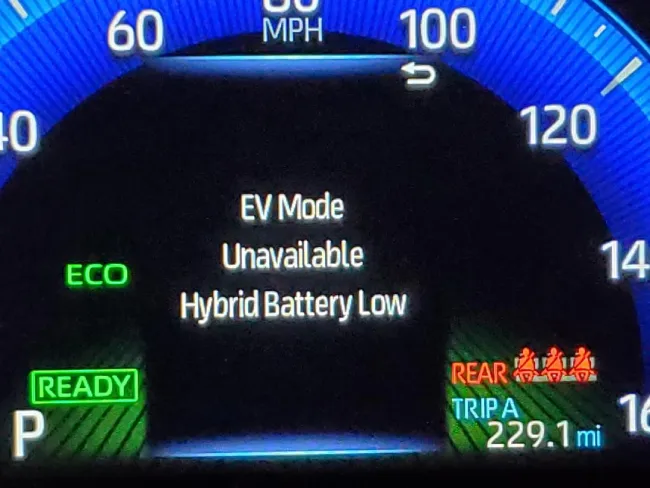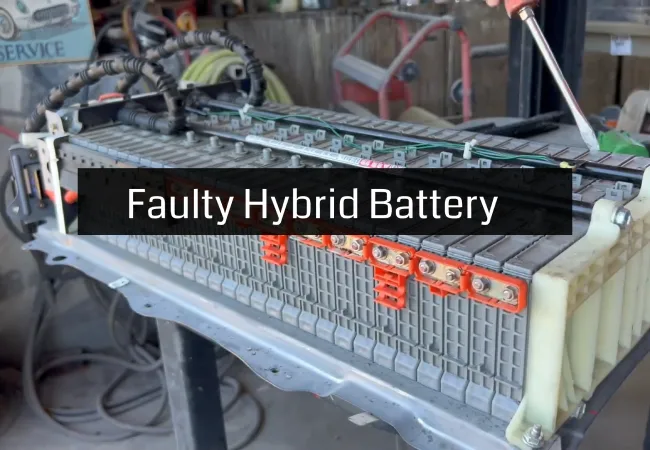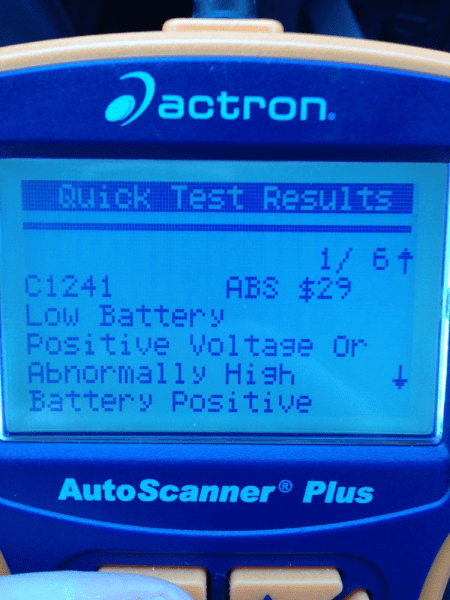In this article, we’ll explore what exactly the P3000 code means on a Toyota Prius, what systems it is associated with, and some of the potential causes behind it. As an experienced auto technician and writer, I have helped diagnose and repair many Toyota hybrids over the years, including multiple Priuses with a P3000 code.
Whether you’re an owner trying to understand what’s wrong with your Prius or a mechanic looking to accurately pinpoint the issue, you’ll find the insights in this article helpful for getting to the bottom of a P3000 trouble code. I’ll also discuss the typical repair options and costs associated with resolving this fault. Let’s dive in and demystify the meaning behind the P3000 service code on the technologically advanced Toyota Prius hybrid.
Here’s What the P3000 Code Indicates On Prius
The P3000 code on a Toyota Prius indicates a malfunction with the hybrid battery control system. Common causes include a faulty hybrid battery, defective battery ECU, loose or corroded connectors, and moisture ingress. Diagnosis involves scanning for related codes, inspecting the battery and connectors, and monitoring battery voltage.

Fixing loose connectors or replacing the battery ECU often resolves the issue, but replacing the hybrid battery is more expensive. Proper diagnosis is important to avoid unnecessary hybrid battery replacement.
Symptoms of P3000 Code
When the P3000 trouble code is set on a Toyota Prius, it means there is some kind of fault causing abnormal operation of the hybrid drive system. But what actual symptoms might you notice from the driver’s seat if this code is present? Here are some key signs of a P3000:
Red triangle warning light illuminated on dash
One very clear indicator is the illumination of the red triangle warning light on the left side of the Prius dash. This light signals an issue has been detected somewhere within the hybrid powertrain and is one of the classic symptoms of a P3000 code being active.
Poor fuel economy and acceleration
With the P3000 affecting motor control, you will likely notice a significant decline in fuel mileage and sluggish throttle response. The efficient electric-only driving capability is limited, forcing more use of the internal combustion engine. Higher than normal fuel consumption and lackluster takeoff acceleration characterizes a P3000.
Error messages or other codes related to the hybrid system
The Prius computer may log additional DTCs pointing to components like the battery, inverter, or motors. Codes for voltage problems, sensor faults, or transmission issues are not uncommon side effects. You may see multiple warning messages displayed related to these additional diagnostic trouble codes.
Inability to drive on electric-only mode

One of the key benefits of the Prius hybrid is its ability to drive short distances solely on battery power. But the P3000 severely hinders this electric motor-only operation. The gas engine may run continuously and you’ll notice the EV mode option is no longer available due to the hybrid system performance being compromised.
Intermittent stalling or shutdowns
If the P3000 causes voltage or battery power fluctuations severe enough, it can lead to the hybrid system stalling unexpectedly while driving or failing to start up properly. The car may try to enter a fail-safe mode automatically due to the faulty voltage readings. These dangerous intermittent stalling symptoms point to resolving the P3000 promptly.
While the check engine light may come on as well with a P3000, the other dashboard warnings and performance changes are clearer signs an owner is more likely to notice. If you experience decreased fuel economy, acceleration concerns, or odd hybrid-related behavior, don’t ignore these warning signs. Have the P3000 and related codes diagnosed and repaired to get your Prius back to peak efficient hybrid operation.
Related Prius DTC: What Does Code P0A80 Indicate On A Toyota Prius? Full Guide
Common Causes of P3000 Code On Toyota Prius
When the P3000 trouble code appears on a Toyota Prius, it means there is an issue within the hybrid drivetrain system that requires diagnosis and repair. But what specifically causes this code to be set? Here are some of the most common reasons and faulty components that can trigger a P3000 fault.
Faulty hybrid battery

One possibility is a malfunctioning hybrid battery pack. The battery provides high-voltage electricity to run the electric motors and is essentially the heart of the hybrid powertrain. Faulty battery cells or a problem with the battery management computer can cause electric power delivery issues. If the battery voltage or current output becomes irregular, it may confuse the inverter and trigger a P3000 code. Replacing defective battery modules or the entire pack if severely degraded may be required.
Defective battery control module (ECU)
The battery ECU is the main control computer that monitors and regulates the hybrid battery pack. It manages vital functions like charging, temperature control, self-diagnostics, and voltage distribution. If this ECU has failed or is glitching, it can send incorrect signals to the inverter and other hybrid components, resulting in hybrid operation problems and a P3000 fault. The battery ECU may need reprogramming or replacement to restore proper control.
Loose or corroded connectors in the battery circuit
The high-voltage cables and connections that link the battery and inverter together can sometimes become loose or corroded over time. This can lead to increased resistance and voltage fluctuations in the circuit that may trigger P3000. Carefully inspecting connectors for damage, cleaning corrosion, and reseating cables can often resolve intermittent electrical faults.
Moisture ingress causing electrical issues
Hybrid components like the battery pack and inverters generate significant heat. Condensation and water ingress can occur over time around seals, gaskets, and breathers. Moisture contamination in high-voltage circuits can lead to voltage leaks and continuity issues that the P3000 code may pick up on. Identifying and repairing leaky components and properly drying electrical connectors is key.
DC-to-AC inverter failure
The inverter converts high-voltage DC electricity from the hybrid battery into AC current to drive the electric motors. If the inverter itself is malfunctioning due to failed power modules or logic circuits, it can certainly cause P3000 trouble codes. A faulty inverter will require professional diagnosis and possible replacement to get the hybrid system running properly again.
Motor speed sensor issues
Sensors monitor the rotor position and speed of the electric drive motors. Bad data from a failed sensor could lead to motor control problems and P3000 faults. Sensor replacement or wiring repairs may be needed in such cases.
Pinpointing the root cause of a P3000 code on a Prius can be tricky without proper diagnostic experience. While the problem may seem initially battery-related, keep an open mind to other possibilities within the hybrid drivetrain. Thorough troubleshooting and testing of all components is key to an accurate diagnosis and repair. However, addressing any of the common sources outlined here is likely to put you on the right track to solving a P3000 issue.
Diagnosing the P3000 Code On Prius
When the P3000 trouble code shows up on your Prius, how do you definitively track down the source of the problem and confirm what is causing the fault? Here are some important diagnostic steps to take:
Scanning for additional related trouble codes with an OBD2 scanner
Generic OBD2 code readers can pull the P3000 DTC, but may not show other supplemental hybrid-specific codes that Toyota uses. Connecting a professional-grade scanner that can access the manufacturer enhanced codes can provide additional insights.
Look for other pending or active codes that may indicate issues with specific hybrid components like the battery, inverter, or motors. These other DTCs can help narrow down the root cause. I have included a section right at the end of this article, explaining related trouble codes.
Inspecting hybrid battery and connection terminals for damage
Take time to closely examine the orange high-voltage cables, terminals, and connections between the battery and inverter. Look for any loose, bent or corroded connectors that may be causing electrical resistance and intermittent faults. Also check the battery case and sub-components for any obvious signs of physical damage, leaks or issues. Faults may be present even if not clearly visible.
Checking battery control module (ECU) for fault codes
The battery ECU has self-diagnostic capabilities to detect internal failures and battery management issues. Accessing its fault code memory with a scanner can provide definitive clues if the battery ECU itself is malfunctioning. Any logged faults point to the battery control computer as the likely culprit. The ECU codes are key to read even if the main P3000 code doesn’t directly indicate a battery problem.
Monitoring battery voltage and performance with a scanner
While driving the Prius, connect a live data scanner to monitor the hybrid battery in real-time. Check for any unusual voltage readings, dramatic fluctuations, or differences between battery modules. Also, note if battery state of charge or assist levels are abnormal. Voltage issues while under load can reveal failing battery cells or connections that may be harder to detect when static. Always compare readings to factory specifications.
By combining the main P3000 DTC with supplemental trouble codes, measured battery values, and visual inspections, technicians can accurately isolate the problem area. Don’t assume the hybrid battery is bad just based on the primary P3000 code alone.
Confirm failures with multiple sources of diagnostic evidence before making any replacement recommendations. Precisely pinpointing the cause of the P3000 fault is essential to an efficient and cost-effective repair.
Related Prius DTC: Code P0300 Prius – Meaning, Causes & Fixes
Repairs and Cost Considerations
Getting that ominous P3000 trouble code resolved on your Prius doesn’t have to be an expensive repair if you understand the possible fixes and costs involved. Here is an overview of some repair considerations and typical price estimates:
Fixing loose connectors or cleaning corrosion usually resolves code
One of the least expensive and simplest fixes is to thoroughly inspect all connectors and cables between the battery and inverter. Tightening any loose clamps, cleaning off corrosion, or replacing damaged cables/terminals can often get the hybrid system working normally again for minimal cost if this is the root cause. Spending time on inspection and minor repairs should be done before assuming major components are faulty.
Replacing battery ECU if diagnosed as faulty, around $500+ parts/labor
If you get the battery control module diagnosed as the culprit through trouble code scans and diagnostic testing, replacing it is significantly less expensive than tackling the entire hybrid battery. The battery ECU replacement part itself usually costs $350-$600. With 1-2 hours of shop labor, it typically totals $500-$800 and resolves the P3000 in cases of a bad ECU.
Replacing a defective hybrid battery is far more expensive $2000-$4000+
While not the most common cause, a failed hybrid battery pack can certainly trigger a P3000 code. But battery replacement is a very costly repair, easily ranging from $2000 for a refurbished pack up to $4000+ for a new OEM stack. Add substantial labor charges for the lengthy installation process and it becomes a serious expense. Batteries weakened by age, damage or high mileage are not usually worthwhile to replace unless absolutely necessary.
Consider battery refurbishment as middle ground option
Some shops offer hybrid battery refurbishment or remanufacturing services to restore only the damaged cells instead of full replacement. This can sometimes fix the P3000 for $1500-$2500, saving thousands over a complete new pack. However, results and longevity vary widely depending on the technique used. Still, an alternative option to explore in applicable situations before committing to an entirely new battery.
Getting supporting diagnostic tests done and exploring the less expensive fixes first is wise before making any high-dollar battery decisions. While the P3000 code on your Prius may seem intimidating, understanding the costs and options available will help you make the repair effective and affordable.
Related Prius Article: Prius P Lock Malfunction – Causes, Troubleshooting & Fixes
The Associated Codes and What They Indicate
The cause of the problem may be indicated by a suffix appended to the P3000 fault code (for instance, P3000-388). This section provides an explanation of various suffixes, sometimes known as INF codes
P3000-123: Battery electronic control unit (ECU) signal abnormality is usually caused by high-voltage battery system failure. and Battery Electronic Control Unit (ECU).
P3000-124: A blown fuse usually causes signaling irregularities from the battery ECU.
Potential causes: Battery Electronic Control Unit (ECU) and High-Voltage (HV) Battery System
P3000-388: Failure of the Mechanisms That Prevent Discharges. When the battery’s charge level drops, whether because the car has been left in the N position, is low on gasoline, or because of a problem with the HV control system, this code is set.
Potential causes of failure include the high-voltage (HV) control system, the HV battery assembly, or a lack of fuel.
P3000-389: The battery ECU has detected a voltage decline. This error is displayed when the HV battery is dead, or there is a problem with the battery management system.
HV battery assembly, HV control system, and other factors may be the cause.
Closing Thoughts
While the fault may seem complex at first glance, hopefully this breakdown has shed some light on precisely what it indicates and the common causes behind it. The key points to remember are that P3000 signifies an issue with the inverter pump motor control circuitry, it doesn’t necessarily mean the hybrid battery itself is bad, and there are a range of factors from faulty modules to loose connections that could trigger the code.
While diagnosing the root cause takes specific troubleshooting and testing procedures, the repair doesn’t have to be an automatic budget-breaker. Many times inspecting connections, cleaning corrosion, or replacing a smaller component can resolve the problem at a reasonable cost if addressed early.
But leaving it unfixed risks more severe hybrid system damage and expensive repairs down the road. Equipped with the diagnostics insights and potential fixes covered here, you can now approach that intimidating P3000 code with greater confidence and understanding. Getting the issue properly identified and fixed promptly will have you back on the road enjoying Prius’s impressive fuel efficiency and performance in no time.
Engineering Coordinator with 5+ years of experience in the automotive manufacturing industry. Currently supporting vehicle development and new model launch activities at Honda Development and Manufacturing of America. Skilled at managing engineering teams, overseeing prototype builds, coordinating testing, and driving continuous process improvements. LinkedIn









